
The US Department of Energy (DOE), Office of Nuclear Energy (NE) and Office of Science (SC) are seeking an Expression of Interest (EOI) from universities, companies, or organisations who are interested in the Molten Salt Reactor Experiment (MSRE) secondary loop salt coolant for nuclear reactor applications. Applications may support any stage of the reactor life cycle from concept through operations, and may include experiments, related testing, and/or direct use in a reactor. DOE says it is not currently preparing any requests for information, requests for proposals, or funding opportunity announcements related to this EOI.
DOE is looking to organisations interested in using, for nuclear reactor applications, the 2000 kilograms of fluoride-based salt (FLiBe) from the secondary coolant loop of the Molten Salt Reactor Experiment stored at Oak Ridge National Laboratory (ORNL). FLiBe is a mixture of lithium fluoride and beryllium fluoride and is not an off-the-shelf commodity.
The MSRE operated from 1965 to 1969. The 7.4-MWt test reactor used a fuel/coolant of 7LiF-BeF2-ZrF4-UF4 (fluorides of lithium, beryllium, zirconium plus uranium tetrafluoride) in its primary loop and its secondary coolant loop used FLiBe. The pyrolytic graphite core also served as the moderator. The MSRE was based on technology initially developed as part of the Aircraft Reactor Experiment in the 1950s. The MSRE project established proof of concept for reactors powered by liquid fuel and cooled by molten salts.
The FLiBe was stored in a coolant drain tank cell before being transferred to other storage vessels to allow for decommissioning activities. It “is assumed to contain impurities”, the solicitation notes. According to DOE “between 1969 and 1999, the FLiBe salt was most likely exposed to a humid atmosphere at least once”. In 1999, to support decommissioning activities, the MSRE FLiBe salt was remelted and transferred to multiple storage vessels – each with a capacity of about 240 litres and 530 kilograms of FLiBe.
Currently there is renewed interest in molten salt reactors both those similar to MSRE that feature liquid fuel dissolved in salt and those that use molten salt as a coolant passing through a solid fuel core. In both cases reactor developers require data on fundamental salt properties and must develop infrastructure, materials, models, fuels, and fuel mass accountability technologies. Some high priority research areas include salt chemistry, material testing, computational modelling, and technology development and demonstrations. DOE is seeking responses from such developers, who may be interested in making use of the stored FliBe. Responses will be evaluated by relevant DOE organisations, including the offices of Nuclear Energy and Science.






